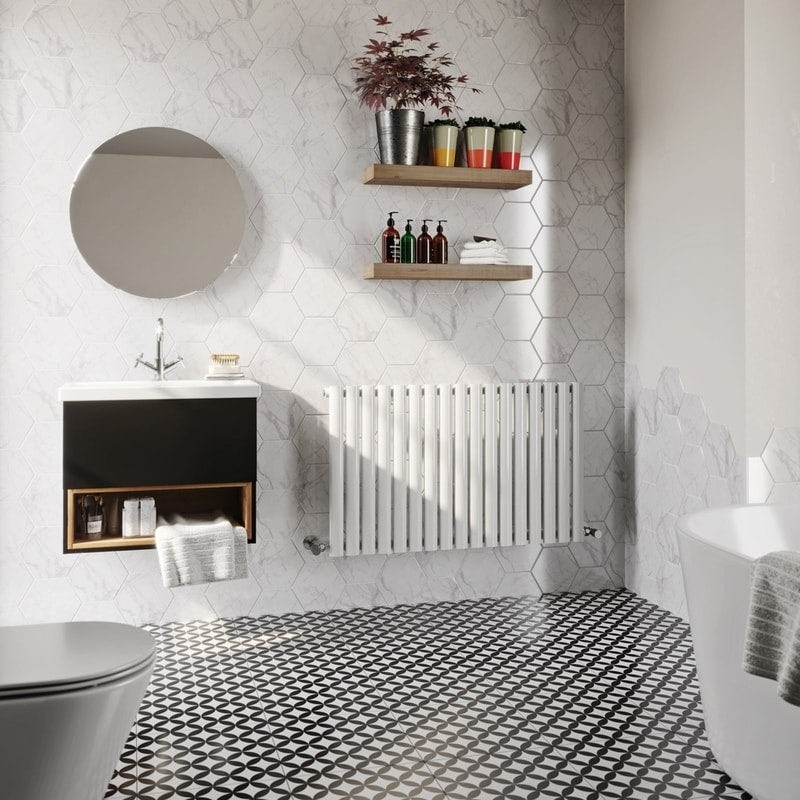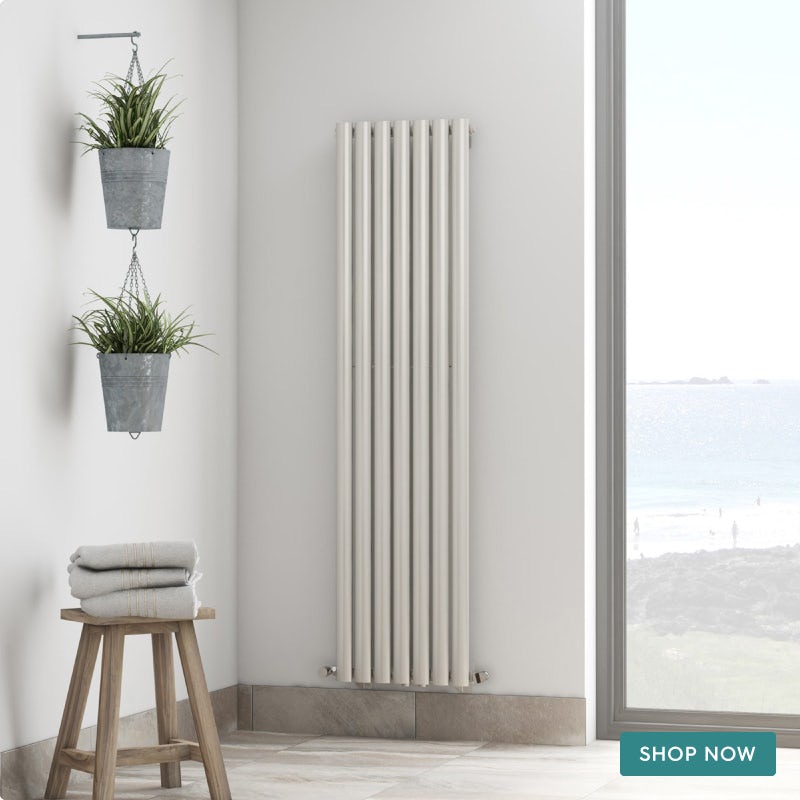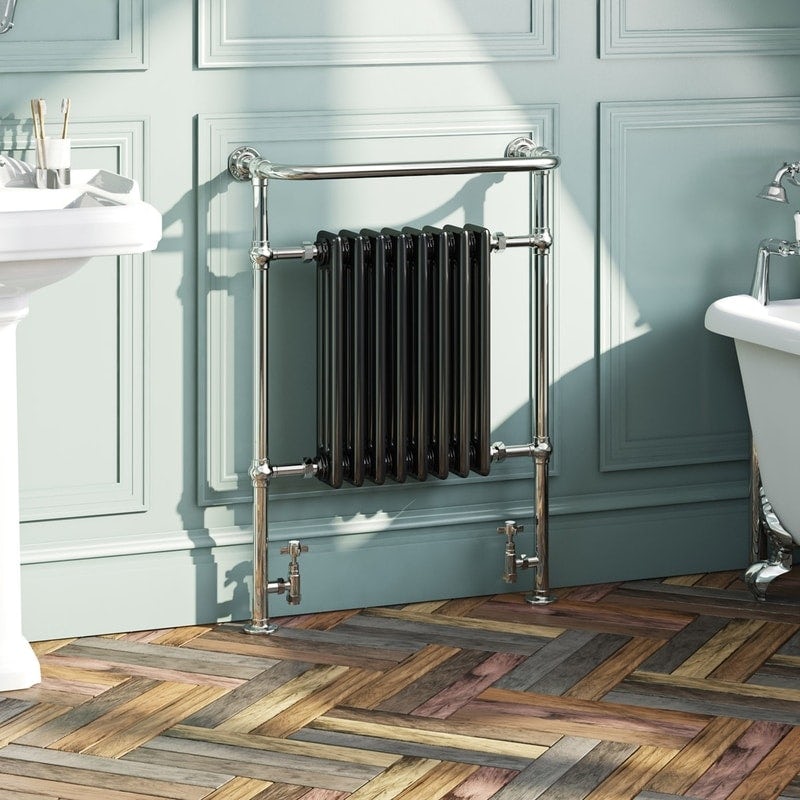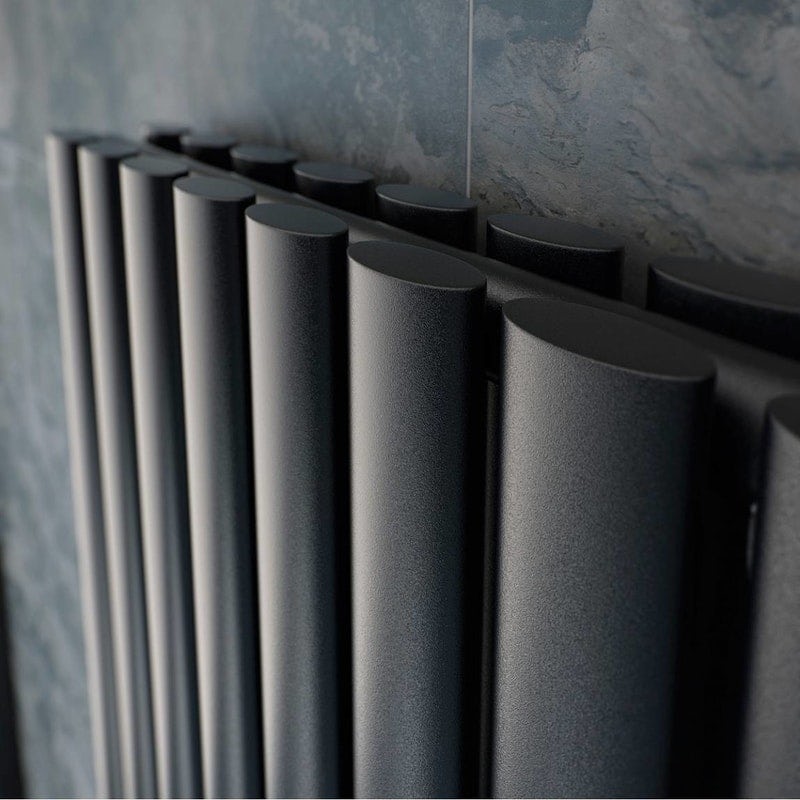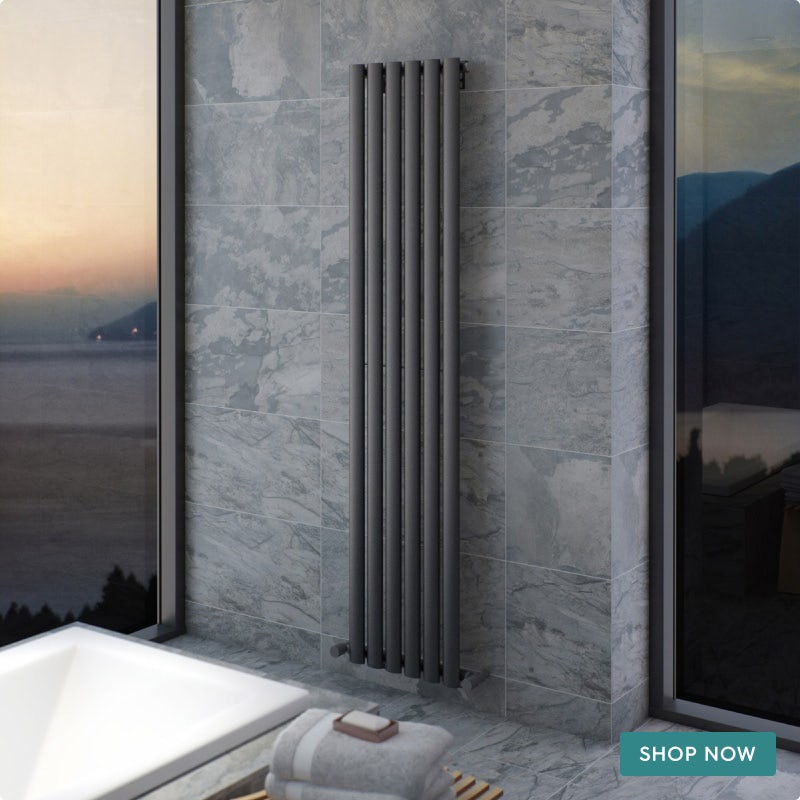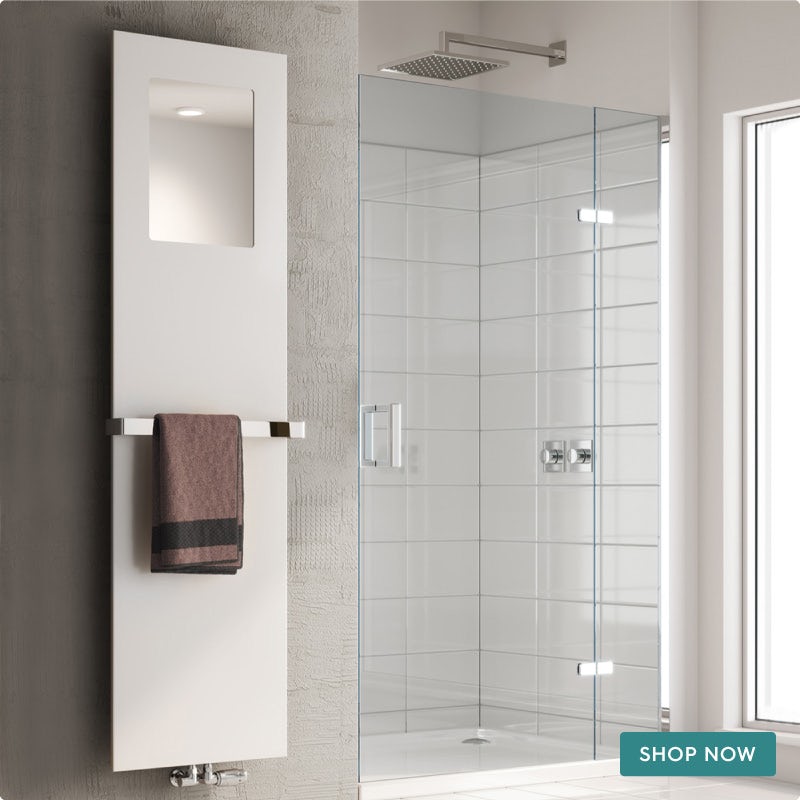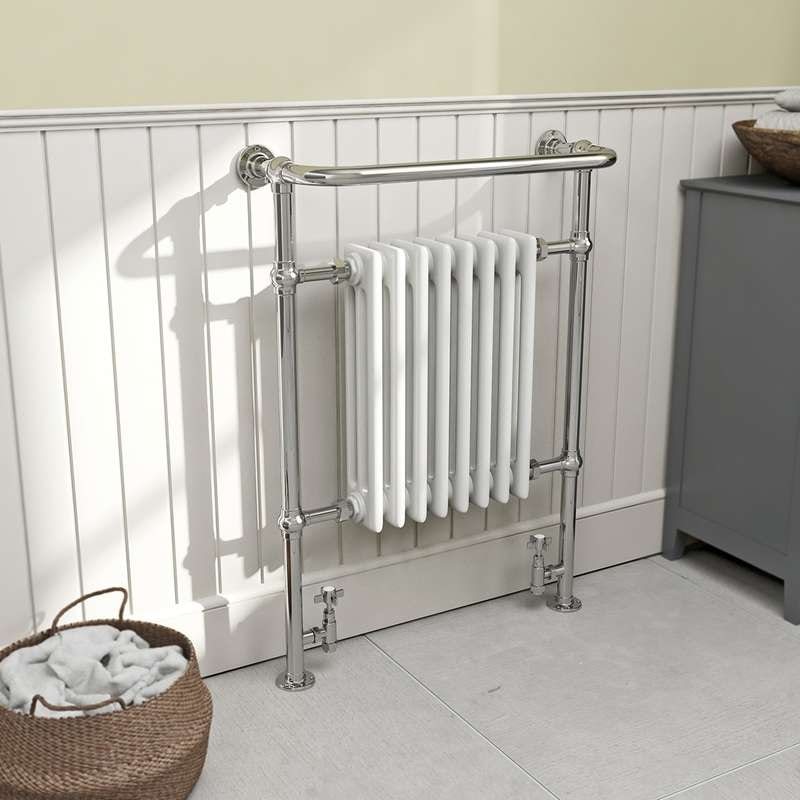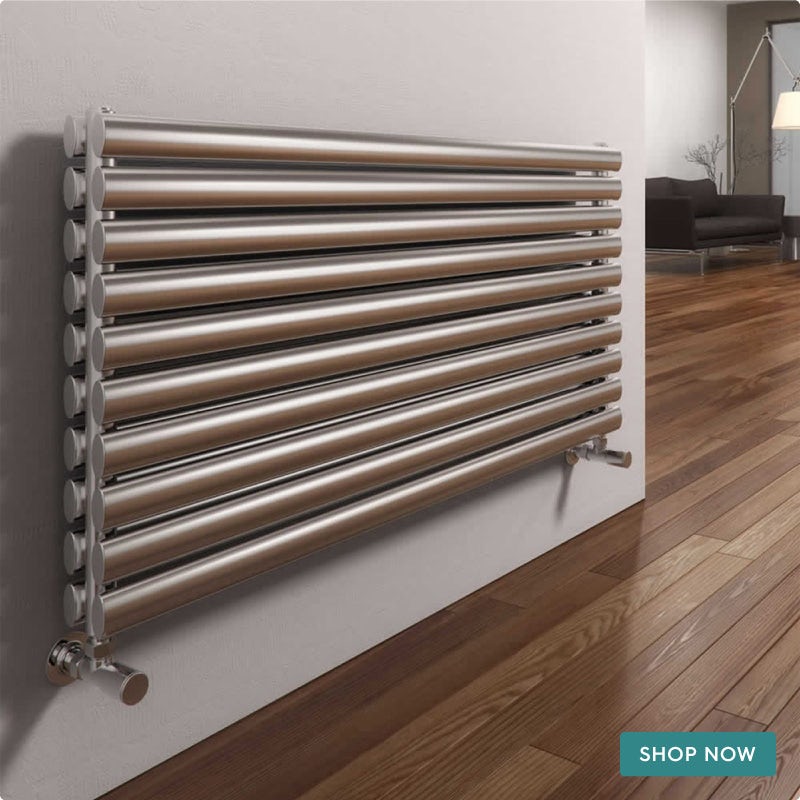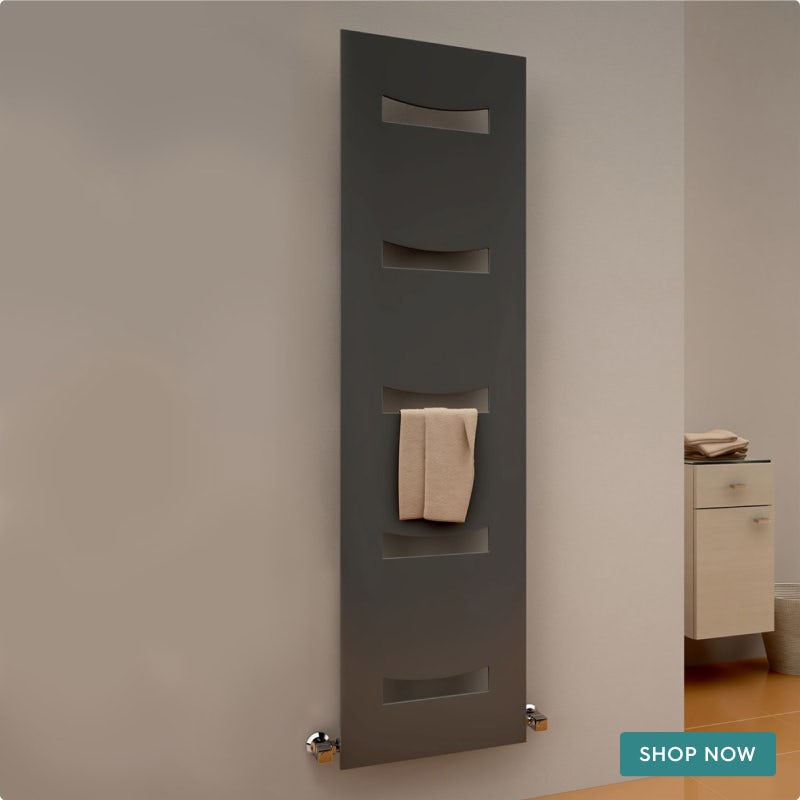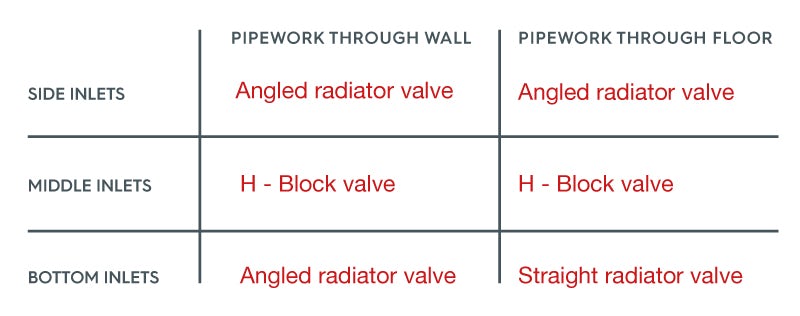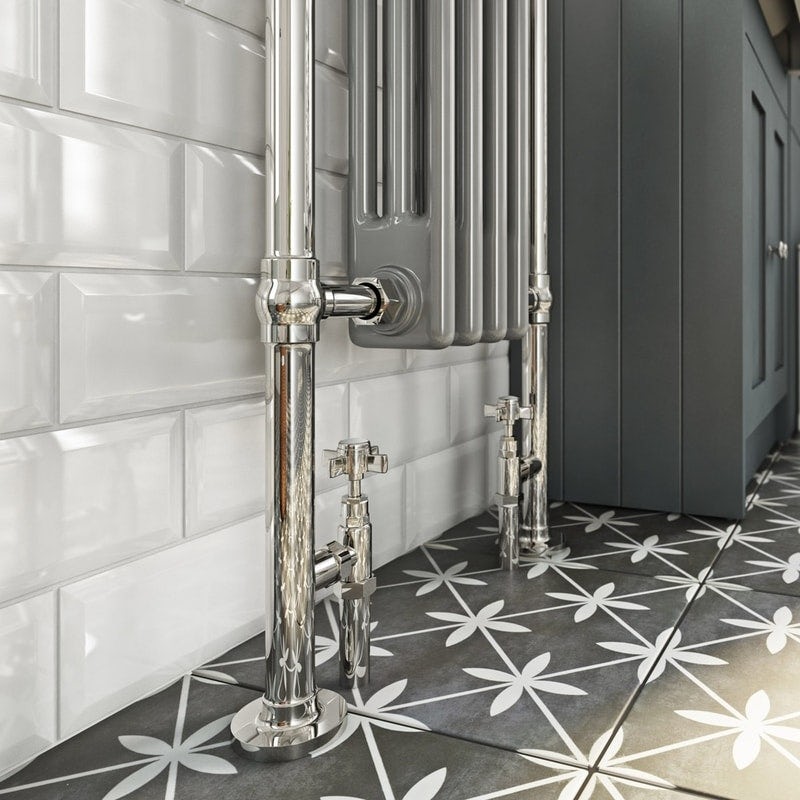Looking to buy new radiators for your bathroom? In this expert bathroom radiators buying guide, we’ll take you through your options, showing you how size, style and design can make a real difference to your interiors.
When the weather gets a bit colder, radiators play a vital role in keeping our homes feeling warm and cosy. This is especially true in your bathroom, where your choice of radiator will help you relax and unwind. These days, you’ll discover a huge range of bathroom radiators, designed to enhance the look and feel of your space. Whether you’re designing a traditional style retreat or a contemporary spa, you’ll find the right radiator for your needs.
Contents
Click on any of the links below to skip to a relevant topic:
- Before you buy
- Different types of bathroom radiator
- Different styles of bathroom radiator
- Radiator materials
- Which are the most efficient radiators?
- Radiator colours
- Radiator valves
- Shop bathroom radiators
Before you buy
Here are 5 questions you should know the answer to before buying a new radiator.
Where are your pipes located?
If you are looking to keep costs down, you could consider a simple like-for-like replacement with your existing radiator. However, if you wish to reconfigure the heating in your room, you will need to ask a plumber for a quote.
What type of wall do you have?
If you’re hanging your radiator on a solid wall made from masonry or brickwork, you should have no issues with the size and weight of the radiator you choose. However, if you are looking to fit onto a stud partition wall, you will need to consider where you place it. You may also be limited to a certain size and weight.
Which heating system do you have?
Your domestic heating system will usually use one of 2 methods:
- A plumbed central heating, where a boiler heats water which is used in radiators around your home.
- An electric system, which doesn’t use water. Radiators are controlled individually in each room of your home.
You will most likely stick with whichever system you have in your home, however, bathrooms are a little different to the other rooms in your home and you may want to save money by having individual control. If you are creating a new bathroom or cloakroom in your loft space or beneath your stairs, an electric radiator could be a much easier option.
What is your required BTU?
Depending on the size of your bathroom, number of windows and number of external walls, you will need to work out how powerful your heating should be. The heat output of each radiator is known as its “BTU”.
Find out how to calculate your BTU.
Could you be doing more to keep your bathroom warm?
Bathrooms can often be quite draughty, chilly places and, in many cases, this can be due to the age of your home. Therefore, it may be worth finding out how to save heat before looking to solve all your warmth issues with a radiator.
Different types of bathroom radiator
In this section, we’ll take a look at the broad types of radiator available, as well as explaining some common terms used to describe radiator types.
Horizontal radiators
The most common type of radiator, found in homes around the UK, is normally placed horizontally across a wall and made from steel with a white finish. Designed with convector panels, this type of radiator is very efficient, despite not being the most attractive of styles. However, with modern manufacturing techniques, there are far more stylistic options open to you.
We’ll start with horizontal radiators. These work well with pipework which comes through your floor. Great for placing beneath a window, they can take up quite a bit of wall space.
Some radiators are also available with an integrated towel rail, which help to warm towels. However, you could buy a separate towel rail to match the rest of your accessories.
Shop horizontal radiators.
Vertical radiators
A more modern option, these can be used to make optimum use of wall space, so you can fit around other items like toilets, basins, furniture, baths and showers. If your vertical radiator comes with a ladder style design, it could also be classified as a heated towel rail. Read our heated towel rail buying guide for more information on these.
These are also available in slim, space-saving designs, ideal for small spaces, like cloakrooms or ensuites.
Shop vertical radiators.
Floorstanding radiators
Some of our more traditional designs are floorstanding radiators, meaning your wall type isn’t a major concern.
Single radiators and double radiators
Both horizontal and vertical radiators come in single, double and, in some cases, even triple versions.
Single radiators usually have one row of panels and are ideal for smaller bathrooms, ensuites and cloakrooms.
Double radiators, as the name might suggest, are designed with a double row of panels, providing greater heat output—ideal for larger bathrooms.
Radiator types 11, 21, 22—what are the differences?
If you don’t work in the plumbing trade, you may never have heard of the radiator types 11, 21 and 22. However, when looking into buying a radiator, these are numbers and terms you may come across more frequently. We’ve answered some of the most frequently asked questions below.
What is radiator type 11?
Radiator type 11 comes with a single panel and a single row of convection fins, which allow for greater heat transfer from the radiator itself. The typical type 11 dimensions can vary.
What is a type 21 radiator?
A type 21 radiator comes with 2 panels, to the front and rear, with a single row of convection fins.
What is a type 22 radiator?
A type 22 radiator comes with 2 panels to the front and rear, with a double row of convection fins.
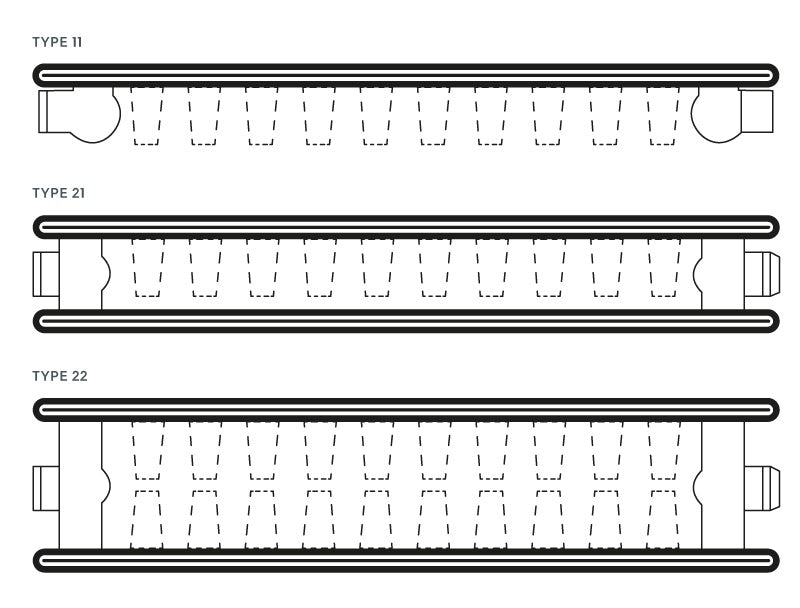
What is the difference between type 11 and type 22 radiators?
The difference between type 11 and type 22 radiators is that there is only one panel on a type 11 radiator, whereas a type 22 radiator features 2 panels (to the front and rear).
What is the difference between type 21 and type 22 radiators?
A surprisingly common question, when people are shopping around for radiators is “What’s the difference between type 21 and type 22 radiators? The main difference is that a type 21 radiator comes with a single row of convection fins, whereas a type 22 radiator features a double row instead.
Whether you choose a type 11, type 21 or type 22 radiator, depends on your required BTU output.
Now you know what radiator types 11, 21 and 22 are, you can stop worrying about them!
Different styles of bathroom radiator
Contemporary and designer radiators
At Victoria Plum, you’ll discover a huge variety of contemporary and designer radiators suitable for modern bathrooms.
The Heating Co. is the perfect brand for all your on-trend needs. With slimline designs that are ideal for small spaces and multi-functional radiators, you’re bound to find a design that matches your bathroom. Many of these radiators are available as part of a matching bathroom suite collection, so you can create a coordinated bathroom design.
Shop contemporary radiators.
The Salvador single vertical radiator is one of our bestselling designer radiators, featuring a grey anthracite finish and oval-shaped panels. Available in vertical and horizontal orientations, you can also choose either a single or double model providing the perfect BTU for your room.
If you’re willing to spend a little extra on your bathroom, you may wish to splash out on a designer radiator. We stock a huge range of designer models from luxury brands Reina and Terma.
For example, the Reina Albi white steel designer radiator, pictured below, features a smooth powder coated white surface with a built-in mirror and towel rail.
Shop designer radiators.
Traditional radiators
The Heating Co. is also where you’ll find a fabulous range of classic designs to fit with classic décor. Available in horizontal and vertical designs, traditional radiators usually follow authentic vintage designs, like column radiators.
The Santa Fe traditional radiator is one of our most popular, with a white enamelled core and sparkling chrome rails, it really does look the business.
Shop traditional radiators.
Radiator materials
Our bathroom radiators are made from the following materials:
- Mild steel
- Stainless steel
- Aluminium
Each metal is “conductive” meaning that heat travels through the metal quickly, warming up and rapidly. Let’s take a closer look at the benefits of each material.
Mild steel
An excellent material used in the manufacture of radiators, mild steel is robust, can be easily shaped and helps to keep production costs low. This means mild steel radiators are ideal if you’re working to a budget. To keep them rust-free, ensure you use central heating inhibitor.
Aluminium
Aluminium radiators are renowned for being light in weight, making them ideal for stud partition walls, and incredibly energy-efficient, heating up quickly. They are also widely recyclable when they come to the end of their life, which means you can have an eco-friendly bathroom.
Stainless steel
Producing a look that is incredibly stylish and desirable (see below), stainless steel radiators are a premium choice for bathrooms. With anti-rust properties, they should require little or no maintenance over the course of a lifetime.
Which are the most efficient radiators?
Out of all the materials listed above, aluminium is generally accepted as creating the most efficient radiators. This is due to its high level of heat conduction, allowing it to get up to maximum temperature quickly, using less energy. Of course, there is a trade-off between efficiency and price, and you will most likely have to spend a bit more on the most efficient radiators.
According to boilerguide.co.uk, radiators manufactured before 2000 can be up to 50% less efficient than those manufactured in the 21st century. This is due to more sophisticated modern manufacturing techniques and a response to new industry quality standards and regulations. So, by simply buying a new radiator, you should automatically be improving the efficiency of your heating, especially if your existing radiators are over 20 years old.
At the other end of the scale, whilst materials like cast iron, for example, can look stunning, they also offer some of the least efficient radiators.
For the most efficient radiators to keep performing, you do need to carefully follow any care instructions. For example, with some radiators, central heating inhibitor is recommend, which helps reduce corrosion and limescale.
Radiator colours
Certain colours help to aid heat transference, which is why, in the past, most radiators came in a restricted palette range. However, these days you certainly shouldn’t feel restricted when choosing your radiator finish.
White radiators are quite commonplace and blend in well with a wide range of colour schemes. If you are looking to add a bold finishing touch to a contemporary or traditional bathroom, black radiators are great. Along with grey radiators, they can really enhance the look and feel of a monochrome bathroom.
Metallics are on-trend right now, so you could add to your designer bathroom with chrome radiators or brushed stainless steel radiators.
Shop metallic radiators.
Radiator valves
Of course, if you are choosing a certain style of radiator, you will need to purchase a set of valves to match. Depending on how your pipes are positioned, you will need to choose either angled valves (for pipes which come out of the floor) or straight valves (for pipes which run across the wall). In some instances, you may need what’s known as an H-block valve. The table below, should help you identify which valves you need.
Angled radiator valves are the most common type required, connecting to pipework that comes through a wall or floor at a 90 degree angle.
Whilst less common, straight valves may be used to connect radiators with bottom inlets to pipes coming up from the floor OR used to connect a radiator with side inlets to exposed pipes along a wall.
H-block valves are much less common and only required for a small proportion of our designer radiators from Terma. They fit a middle inlet, where both pipes are 50mm in diameter, optimising space.
To ensure you get compatible valves with your chosen radiator, you can buy complete radiator and valve packs from The Heating Co. or else we’ll suggest suitable valves when you add your radiator to your basket.
Shop radiator valves.
Heating advice
If you’re searching for further advice on heating your bathroom, click on any of the links below to find out more:
- Bathroom heating advice
- Heated towel rail buying guide
- Underfloor heating buying guide
- How to calculate BTU for your room
- How to bleed a radiator
- How to save heat in your home
Shop bathroom radiators
Now that you have a good idea what to look out for, why not shop our range of bathroom radiators today. We’ve no doubt you’ll find the perfect size, shape and style to suit your bathroom. Simply click on the image below to begin browsing.

